Want to attend an IFK Värnamo home match?
You’ll have to be one of the first 5,000 people at the gate. With the second smallest stadium in the Swedish Allsvenskan (by 500 seats), the club celebrates 110 years in 2022.
Managed by the 34-year-old Kim Hellberg, Värnamo is also the club of David Selini, our former colleague and first signing for Total Football Analysis (you can find his tactical analysis articles here), who assists Hellberg.
Värnamo may be a recently promoted side, however, their playing is anything but. Rather than a passive, timid side that absorbs pressure, they’re a high-pressing, line-breaking club with innovative tactics. Just before the latest break, they collected seven points in four games.
This scout report will look at the data behind Värnamo’s season and then take a closer look at the club’s tactics through in-game examples.
IFK Värnamo and Allsvenskan data
Let’s start this analysis with a quick look at Värnamo’s data relative to their Allsvenskan opponents. Looking at the table, Värnamo currently sits in 12th place with 12 points. Comparing reality to expected stats, their performances warrant an xPoints of 15.6, good enough for 7th in the league.
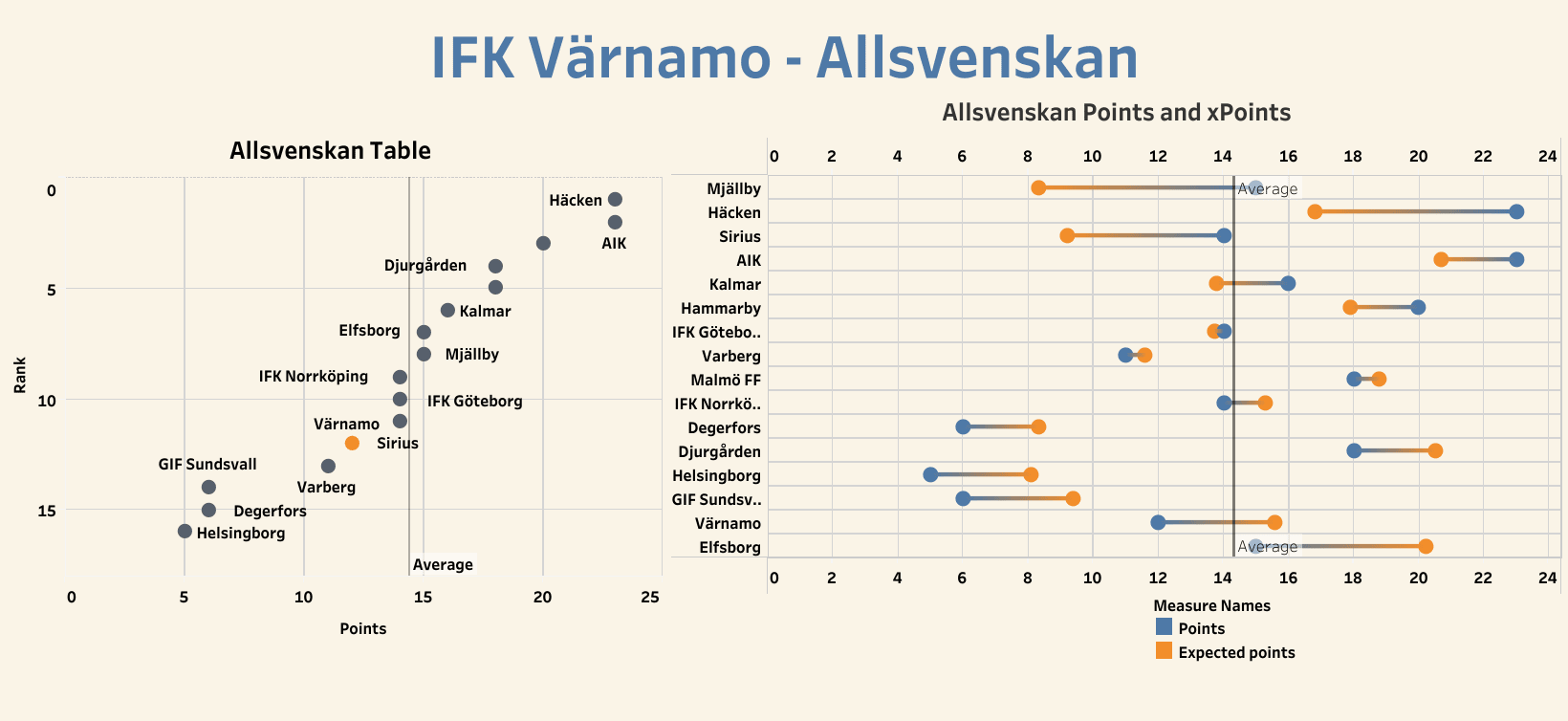
The next data visual looks specifically at their goals for and against, both their actual total and the expected values. Plus, since Värnamo is among the league leaders in interceptions and defensive duels per 90 minutes, which ties into this analysis, we have a visual of those numbers as well.
For the season, Värnamo has 11 goals to their name and 12 against. Comparing that to expected totals, the club has an xG of 14.68 and xGA of 12.14. While their goals against is right where it should be, there is some underperformance in front of the goal. The positive though is that they are finding their opportunities in front of the net.
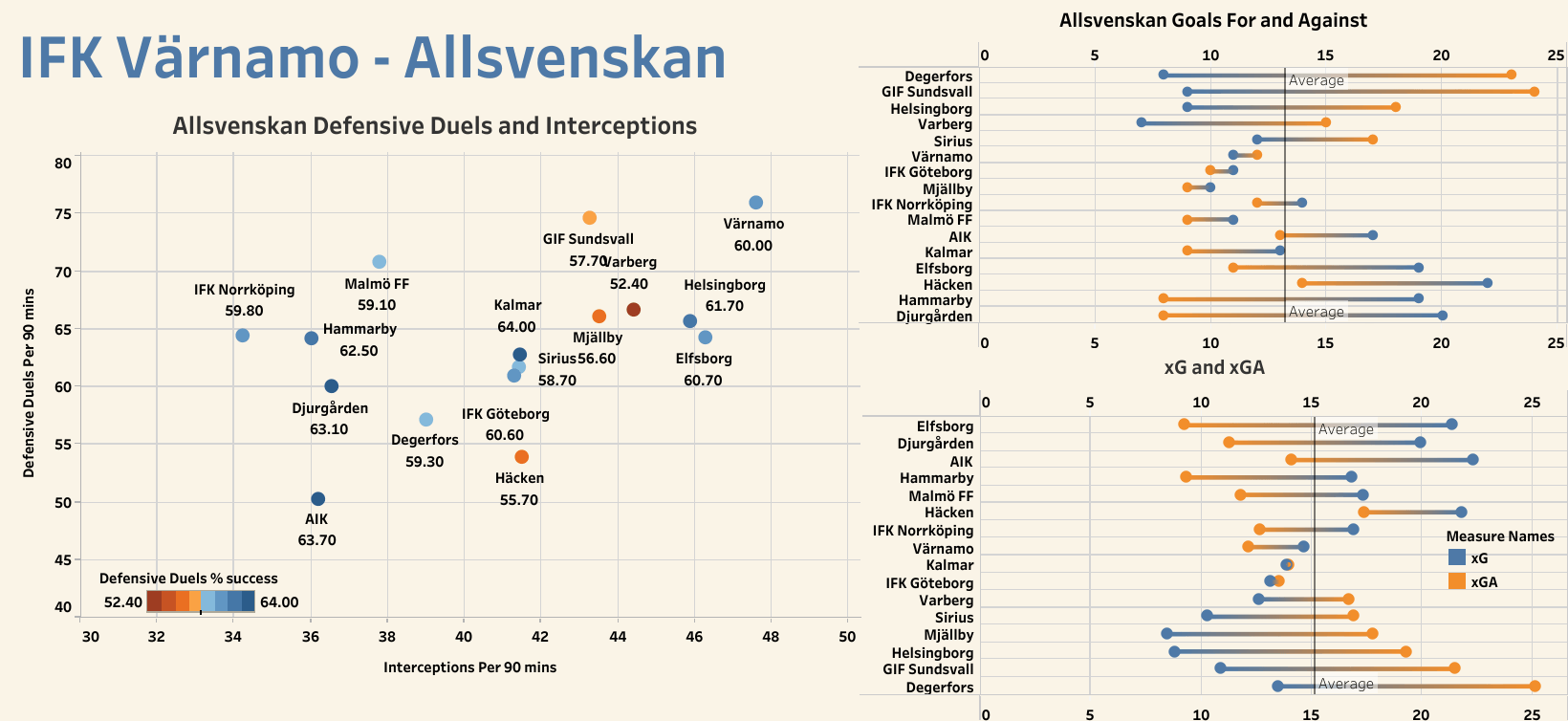
In terms of their system tactics, they’ll typically play with the variation of the 4-3-3. The most common variant is the 4-2-3-1.
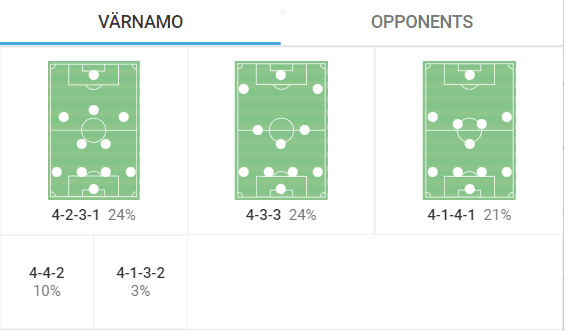
The 4-3-3 is essentially their base formation. As you’ll see throughout this analysis, there are some standard, traditional implementations and concepts at play, but the Värnamo staff has done a brilliant job blending traditional principles with modern concepts. You’ll see a little bit of Pep Guardiola at Manchester City, some of Jürgen Klopp’s Liverpool and the Red Bulls philosophy as seen with current Bayern Munich coach Julian Nagelsmann. This is a club with the courage to innovate. Let’s see how they’ve done it thus far.
In possession
Let’s start with an in possession tactical analysis. Värnamo averages 46% possession, which ranks 13th in the league. Though the quantity of possession isn’t significant, it’s the quality of the ideas they show that impresses.
When in possession, Värnamo is very deliberate in their positional play and the progression cues they’re searching for. This is a side that likes to build out of the back, but you won’t find them casually connecting 15+ passes along the backline. Rather, the centre-backs and pivots have well-trained eyes that search for the right cues to signal a line-breaking pass.
Take the example below. The setup is a fairly standard 4-3-3 in terms of the way the lines are set out. There is one key distinction though, and that is the distance between the outside backs and #8s from the forwards. Frame one shows the basic setup, but it’s the second image that shows the targeted gap between the lines.
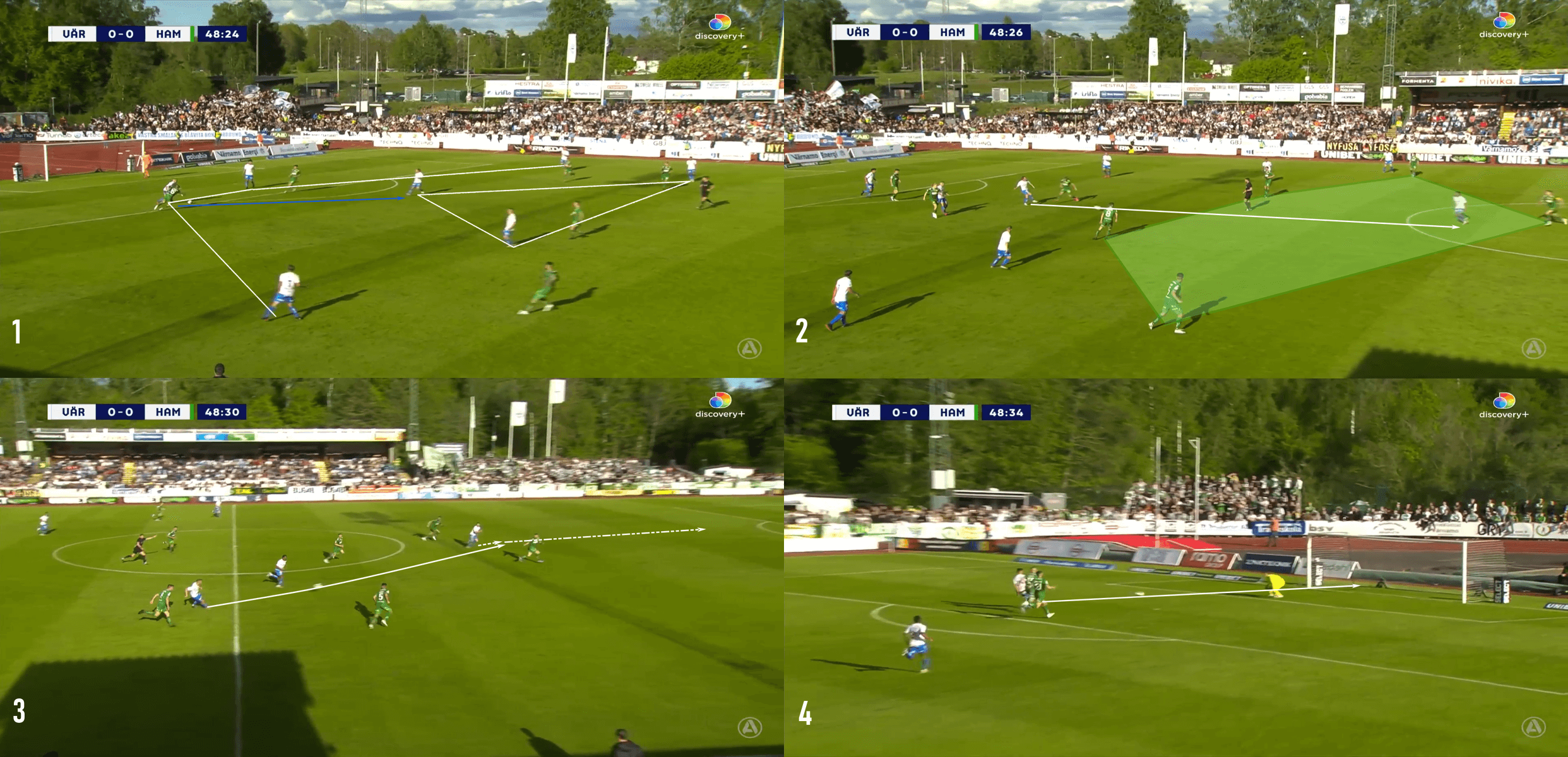
Once Värnamo can play into one of the forwards between the lines, he’s well supported underneath and has two teammates ready to move off of him higher up the pitch. The additional advantage, as we see in the third image, is that the dropping forward can set the ball into a forward-facing midfielder, which directs the two forwards up top to make their moves into space. It’s a well-executed up-back-through pattern that places Marcus Antonsson through to goal, which happened to be the game-winner against Hammarby.
One thing to note is the narrowness of the forwards in that last sequence. This is one of the areas in which the coaching staff has merged a traditional system with the contemporary concept of central dominance. It’s a running theme in there in possession tactics.
Even in open attacks, you’ll find a similar structure. Below, we have what amounts to a 2-3-5 attacking shape, which we’ve covered right here at Total Football Analysis. It’s an approach reminiscent of Klopp’s tactics at Liverpool. With the outside-backs providing width in the formation, the remaining eight outfield players are stationed throughout the central region of the pitch. The 2-3 at the back gives Värnamo the ability to counterpress, contest aerial balls and track down anything played over the top. Those five players give the other five a tremendous amount of freedom.
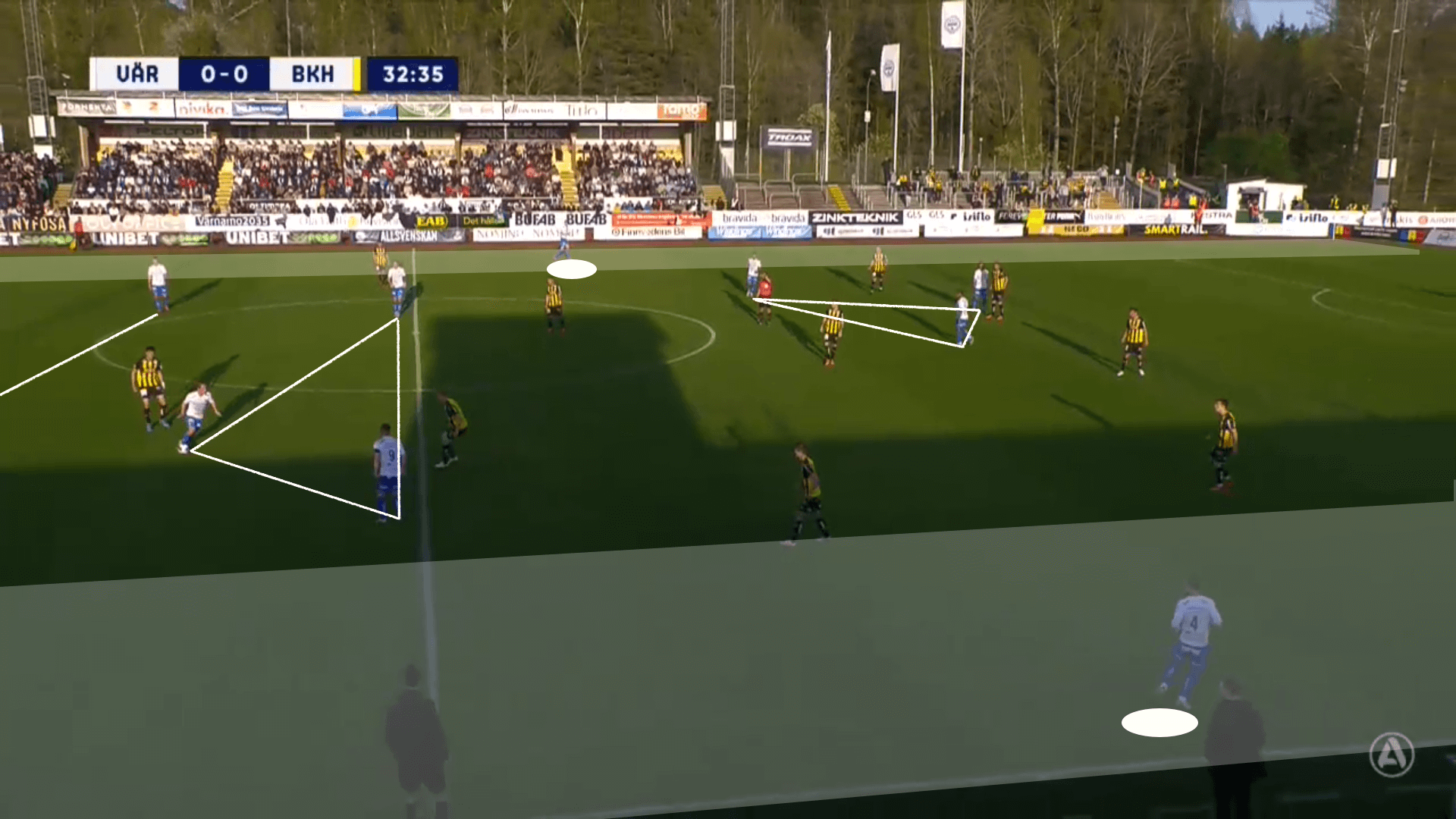
This is a team that can adapt their tactics quite well. Against Mjällby, there was even an inverted outside-backs sighting. Rather than the high central overload, Hellberg opted for high and wide targets in the wings with deeper central options.
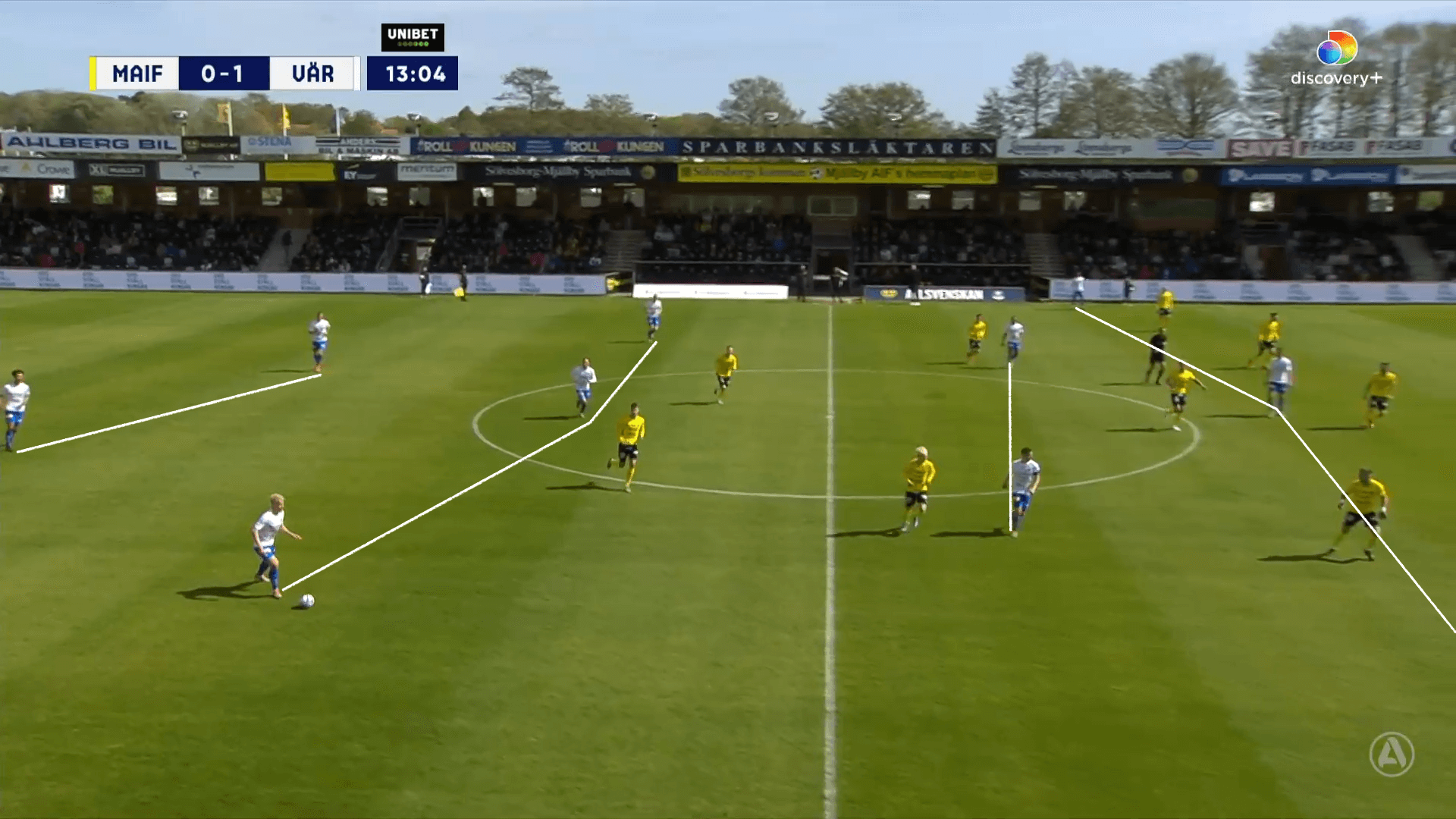
One of the keys to Värnamo’s attacking tactics is that they’re very good at getting numbers into the box. To do that, those players have to be well-positioned to meet the service at the right time. That’s where the high central overload comes into play. Three players interacting with each other at the top of the formation not only pins defenders centrally, giving width to the two outside-backs, but it also ensures they have runners behind, between the lines and to meet crosses.
To keep these players connected, Värnamo often use a compact attacking shape. This is the connection to Nagelsmann. A compact attacking shape leads to a more fluid attack, quicker defensive transitions and prioritises numeric and socio-affective superiorities in tight spaces.
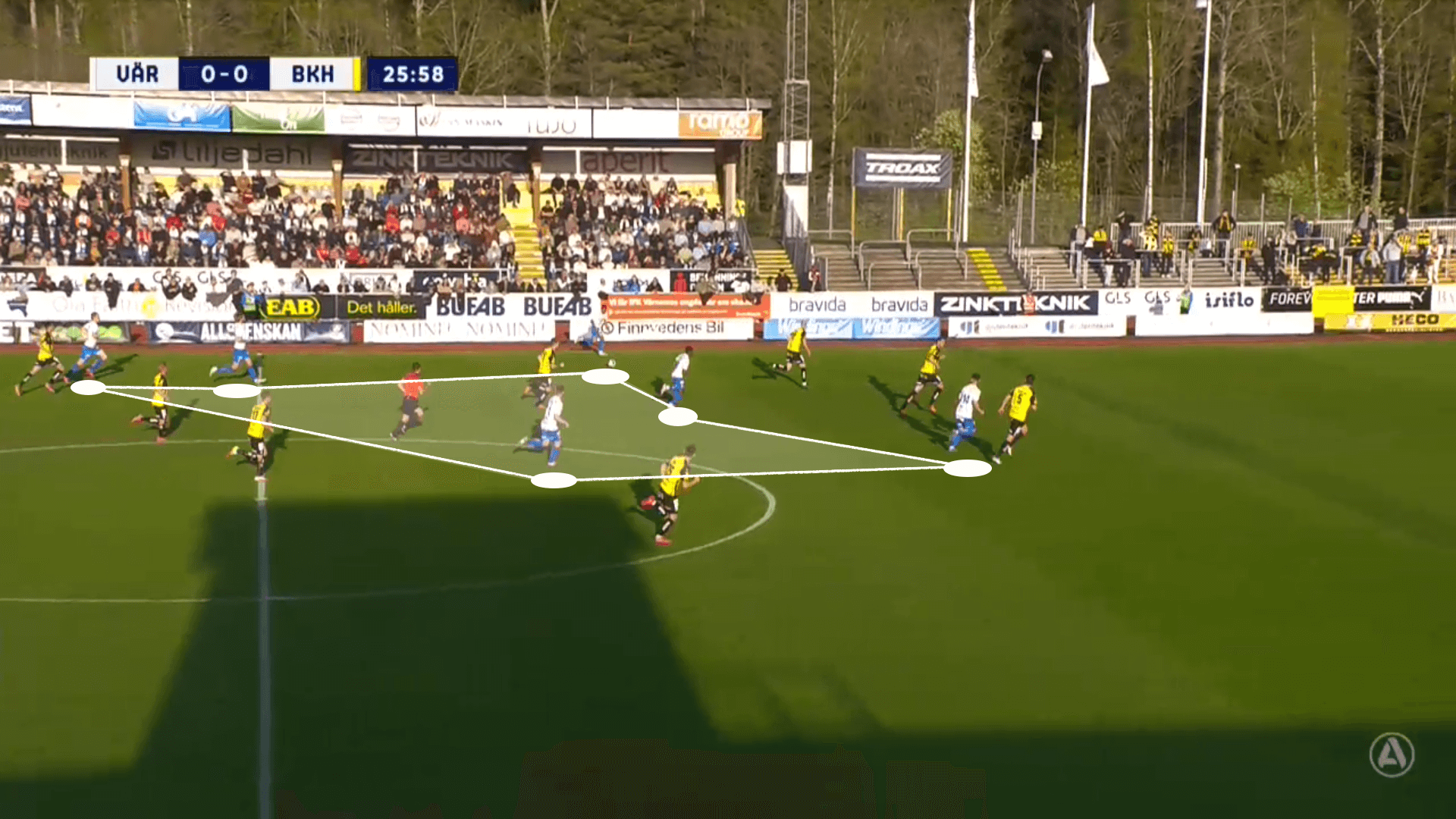
Värnamo’s connectivity throughout the pitch has greatly benefited their play. For the season, their 11 goals are a mid-table tally, but their xG has them within reach of the top third of the table. In their past six matches, they’re averaging 1.8 xG per match, well above their season average of 1.18, as well as the league average of 1.31.
As mentioned, one of the standout qualities of the side is their ability to attack the box. In direct possessions, they use Zone 14 very effectively, slipping runners behind the backline and into the box.
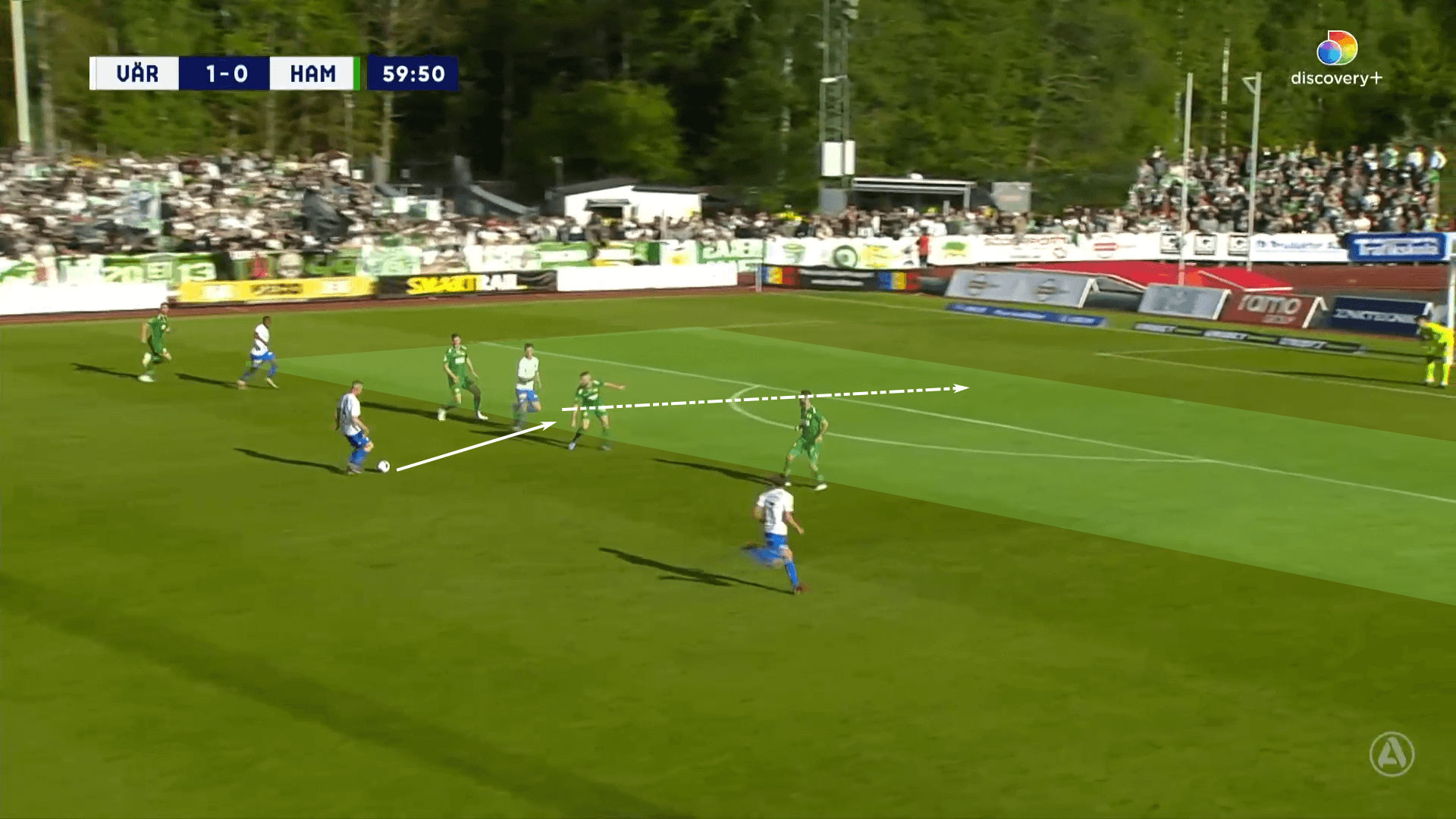
If the central route is unavailable, you’ll find them attacking the wings, getting in or very close to the box before sending a delivery in. Looking at the goals they’ve scored the season, they’re equally effective scoring from cutbacks or more standard crosses from the wings. As you see in the example below, much of that success comes down to the number of runners that get into the box. Though they can leave the midfield exposed to counterattacking situations, Värnamo often gamble at the right moments, frequently establishing a numeric superiority as they look to meet a cross.
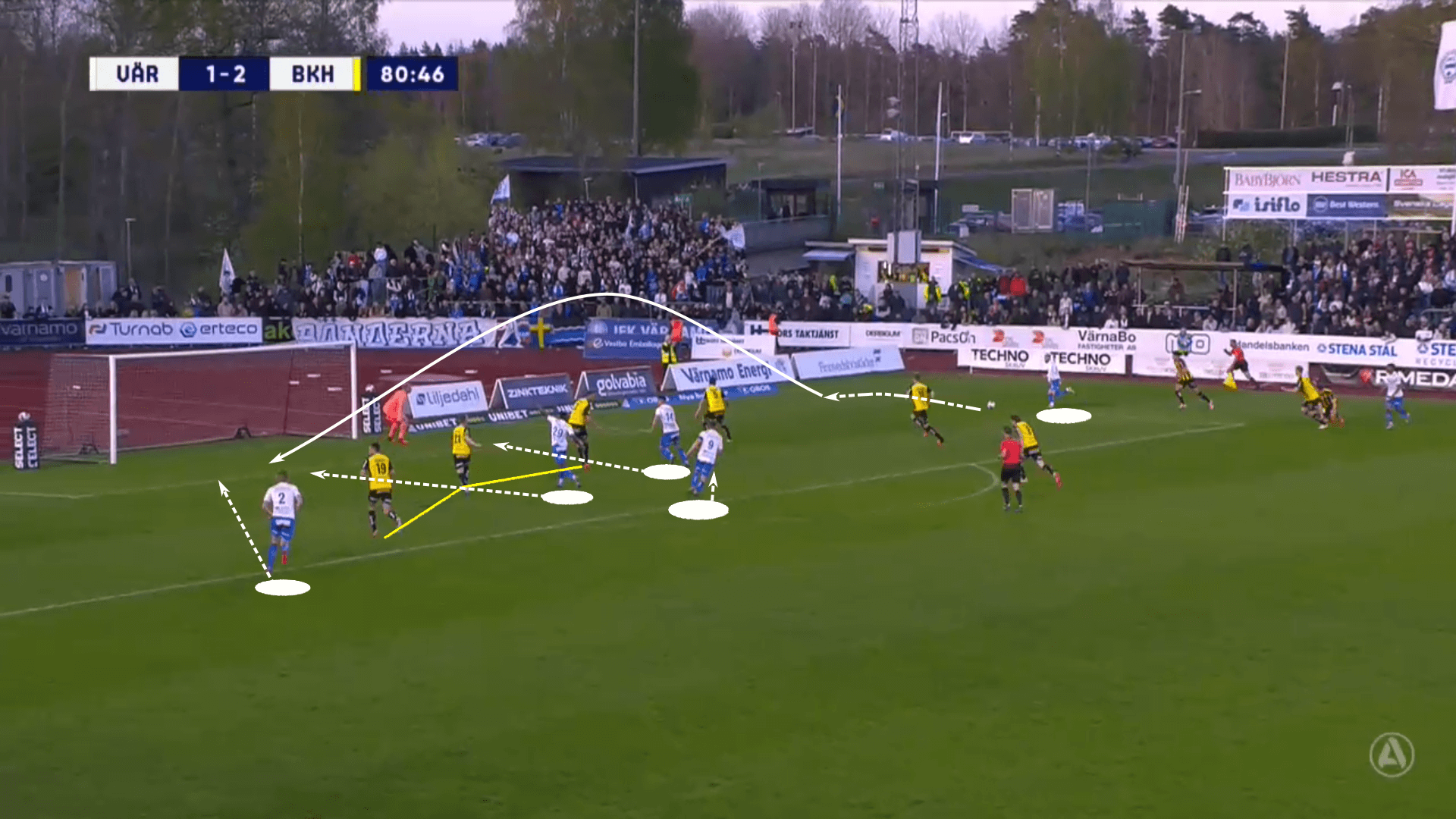
Värnamo work from the base 4-3-3 extremely well. Depending on their expectations of the opponent, they’ve shown a number of in possession adaptations to swing matches in their favour. As opponents prepare for Värnamo, as many have already discovered, it’s not enough to ask how they play. Instead, that’s just the starting point, which then leads to an analysis of how they will adapt their system for the specific matchup.
Out of possession
If you follow Selini on Twitter (@DaveSelini), you’ll know this tactical analysis was inspired by his breakdown of Värnamo’s high press against Hammarby. We’ll look at their high press tactics here, but you should definitely read the thread yourself.
Don’t let the possession percentage fool you. This is not a side that sits back with the aim of absorbing pressure. The newly-promoted side is prepared to challenge the top clubs in Sweden with their high press. In fact, their high press has been a tremendous playmaker for them during the 2022 season.
As Värnamo high press, a +1 at the back is prioritised. If the opposition’s midfielders drop deep to help with the build-out, Varnamo’s pivots have the freedom to continue up the pitch with their mark.
Their shape is very fluid in the high press. That said, there are some constants. They will typically lead with two players in the first line. Their objective is to limit the time and space opposition centre-backs can have on the ball and cut the angle to their near-sided outside-back. When they’re at their best, the ball will eventually find its way into the goalkeeper’s feet, forcing him to lead the build-out.
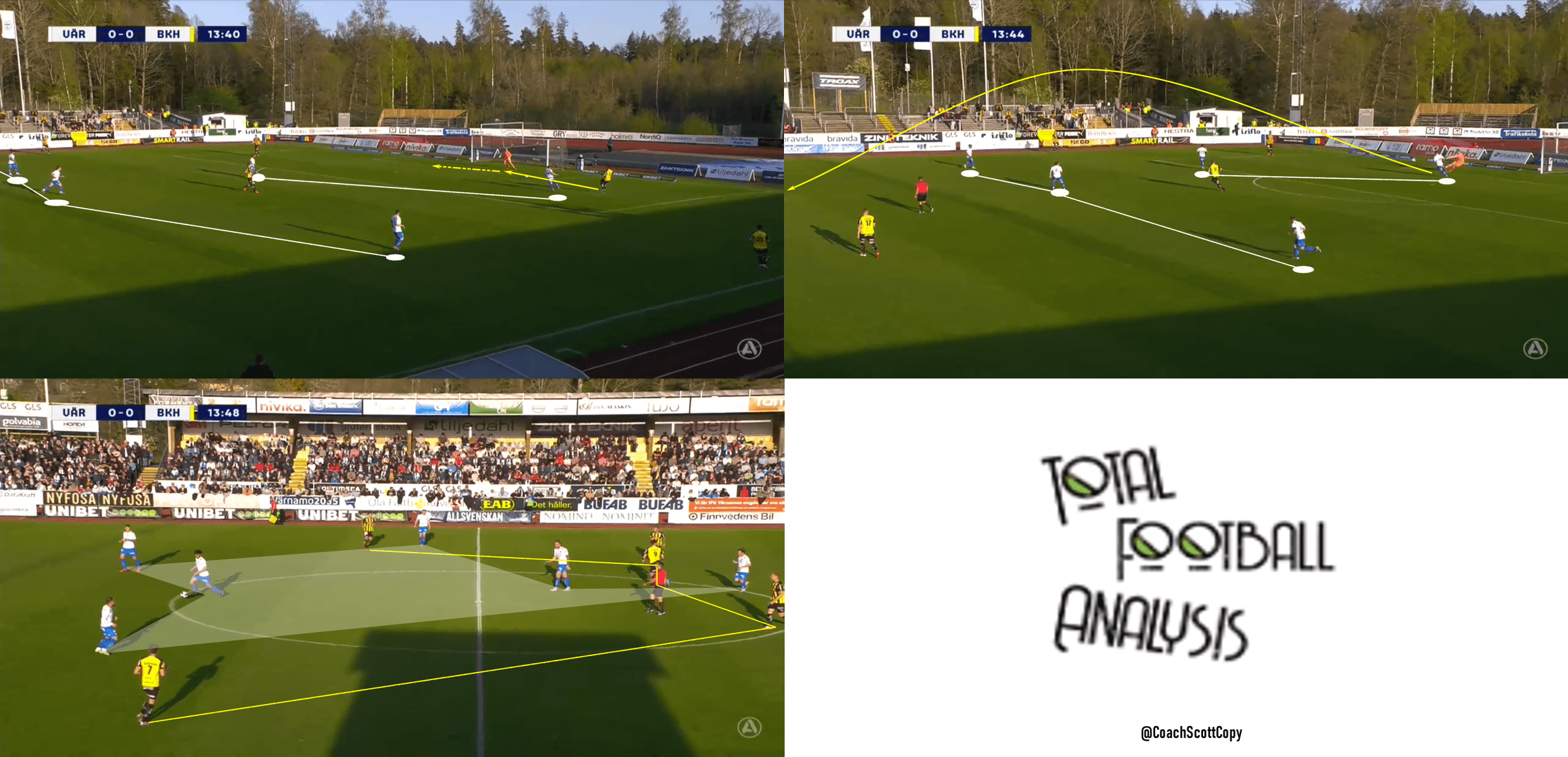
From that deep distribution point, Värnamo effectively elongates the distance to possible outlets, decreasing the likelihood that the pass will find its target. In all likelihood, you’ll see a scenario like the image above where the ball is simply lumped into the middle of the park where Värnamo typically enjoys a numeric superiority by virtue of their compact defensive shape.
When they drop off into a mid block, you’ll find very similar themes. First, preventing the opponent from playing through the middle of the pitch is a priority. The best-case scenario is to funnel the opposition into the wings and then squeeze the pitch to lock them in. The backline is prepared to run if the ball is played over the top and the midfielders in forwards will work hard to earn recovery, keeping the opponent from breaking their pressure.
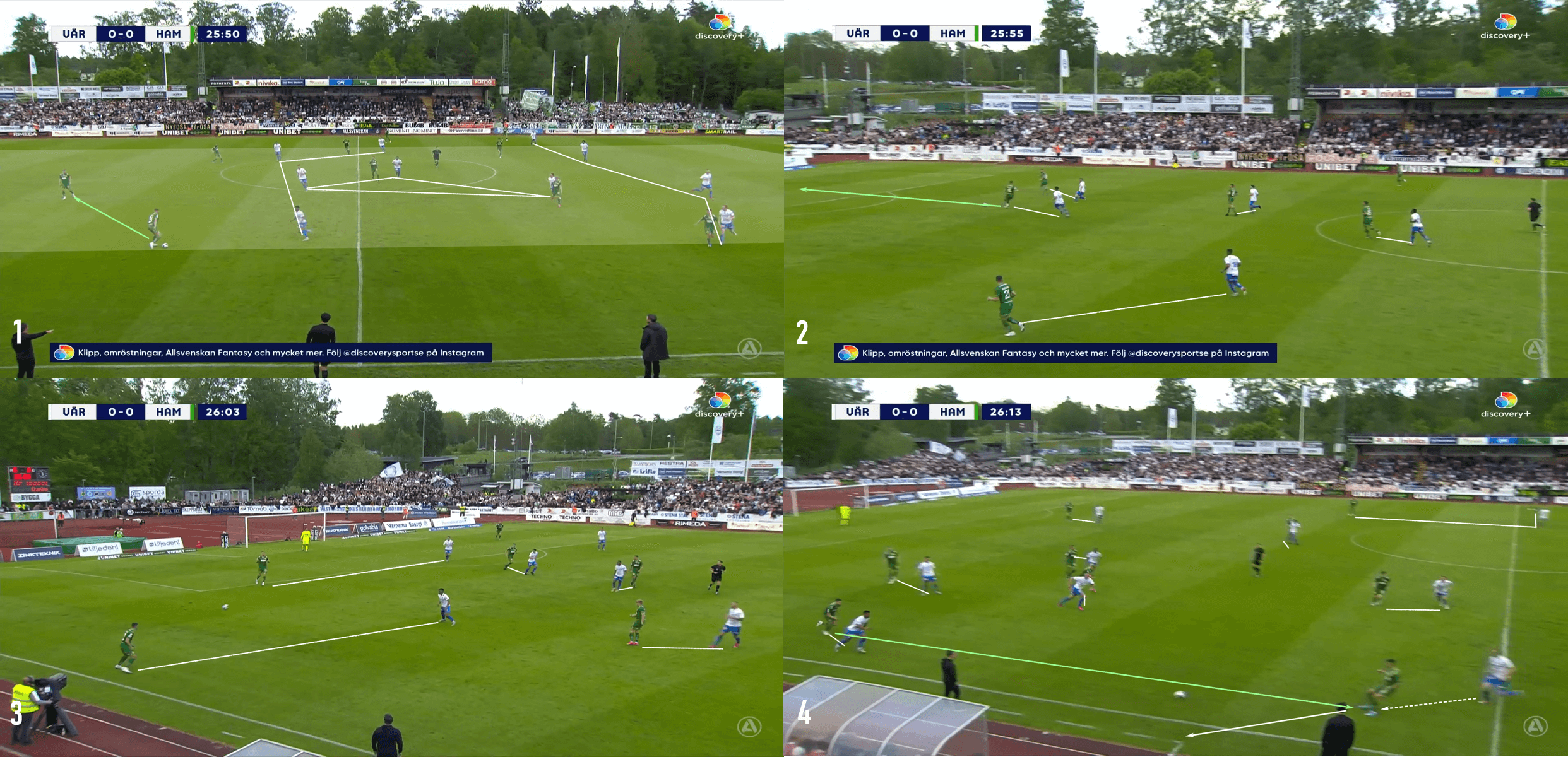
The other outcome is to force the opposition backwards. That’s exactly what we have in this four image sequence. With the centre of the pitch blockaded, Hammarby is forced to play around the press. As space condensed, the one option was to play backwards, leading to a pass into the goalkeeper.
Even though Värnamo was unable to recover the ball, what they managed to do was move into the high press. As Hammarby restart their attack on the right-wing, as seen in image three, the home side is quick to condense space and leave one available option in the immediate passing network. The pass was poked at a balance leading to a Hammarby throw-in and even tighter space given by the out of possession team.
Transition
Looking at Värnamo’s goals, it’s simply impossible to leave their attacking transitions out of this analysis. With five of their 11 goals coming from transitional moments, this is a side that is highly effective in turning recoveries into goal-scoring opportunities. The high press is a playmaker and their counterattacks are lethal.
With their compact, well-structured out of possession tactics, Värnamo is positioned for effective counterattacks. Though they do well to get numbers behind the ball, they also understand that they need numbers higher up the pitch to act as outlets and transitional moments, both with players showing to the ball and others running behind the back line to stretch the pitch and attack space.
The first example from the section is perhaps an atypical one, but it does connect some of the dots to the side’s attacking tactics. Against Häcken, there was a scenario where the visitors looked to play into the final third, but the ball was poked away by Värnamo, into the feet of the goalkeeper, Pilip Vaitsiakhovich, who played forward with his first touch. A flick on by Evaldo Netinho found the chest of Marcus Antonsson, the former Leeds United player, who dropped the ball into the path of Abdussalam Magashy. A quick give-and-go sprung Antonsson behind the backline. His pass to Magashy, seen in frame three, is slightly behind the Nigerian, whose shot is saved by Peter Abrahamsson.
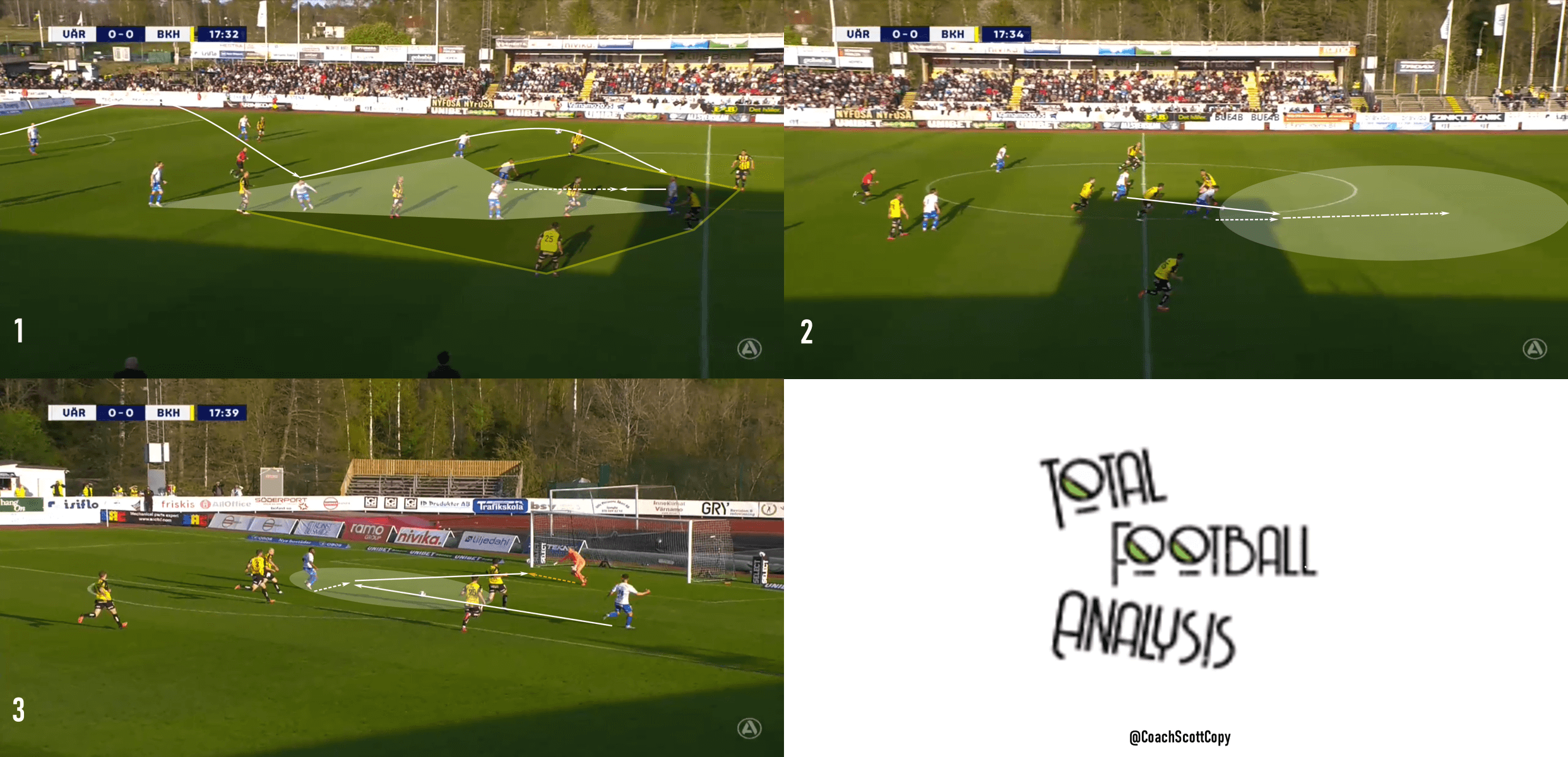
Perhaps the greatest oddity of that scenario is the starting position of the attacking transition. The starting point was much deeper than normal, but the transitional moment was highly effective due to their high central overload.
Let’s move to an example with an attacking third recovery.
Again versus Hammarby, the away side attempted to play out of the back, but had their aerial pass blocked, leading to a Wenderson recovery. As you can see in the second frame, Värnamo has numbers around the ball, but they’re not prepared to make their move into the box. The opposition is still very compact and has the positional advantage in Zone 14. Looking for a different entry into the box, the ball is played wide into the feet of Freddy Winsth.
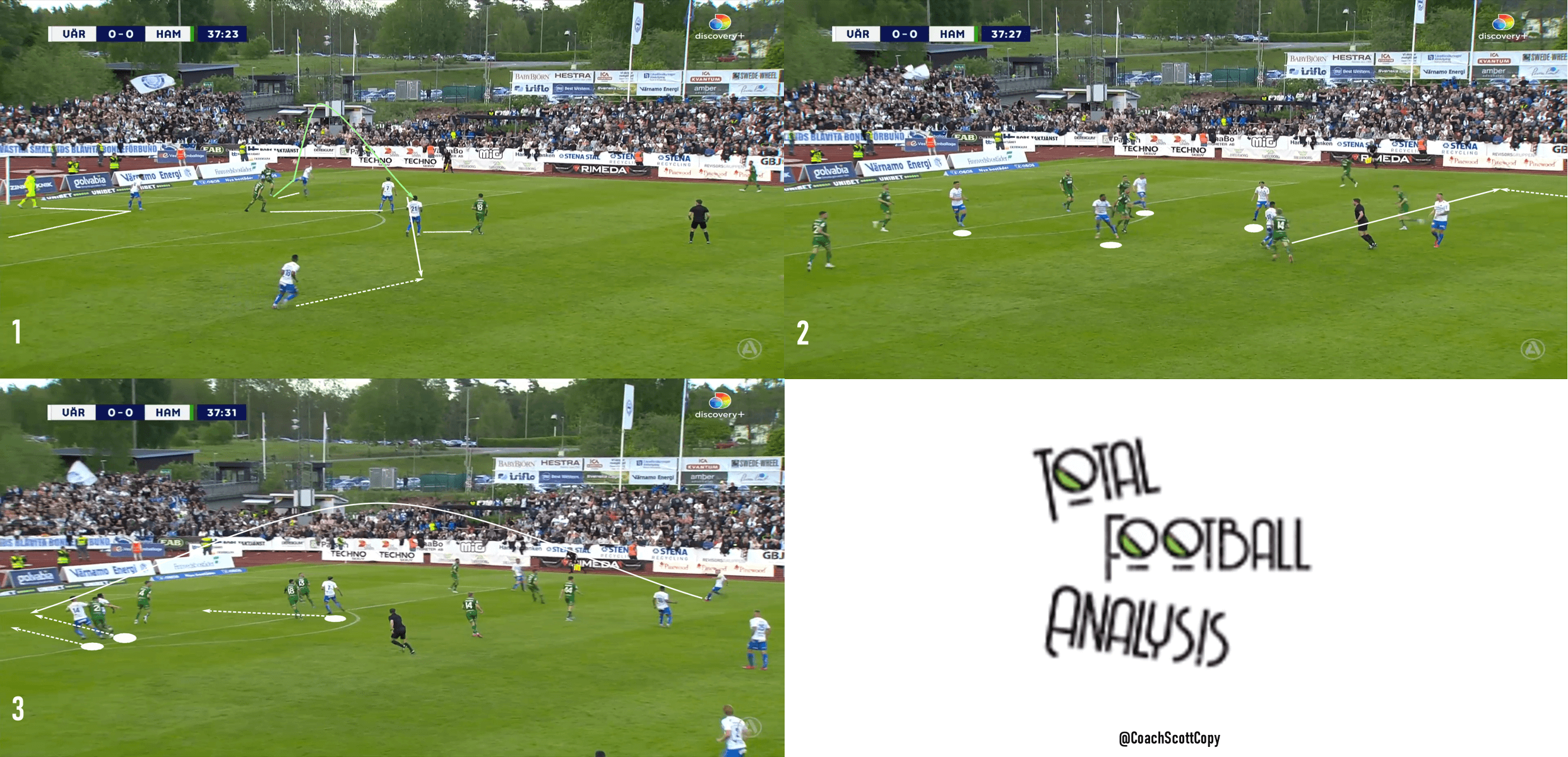
His delivery into the box is a good one, nearly leading to a goal. The bigger point is to notice Värnamo’s numbers attacking the box. Even though the initial moments after the recovery did not lead to a path forward, the players still moved into position to attack the box, taking advantage of the few seconds created by Wenderson’s pass into the wing.
The work rate of the forwards has been key to Värnamo’s attacking surge. Regardless of the three up top, they’re very active attacking the spaces between the lines with coordinated movements behind the backline. They play off of each other very well and have a very good understanding of which movements trigger which responses.
When Värnamo starts an attacking transition, you’ll always find at least one runner behind the line. In the instance below, we have two. With the first attackers in forward-facing positions, they are well-positioned to lead their runners into space.
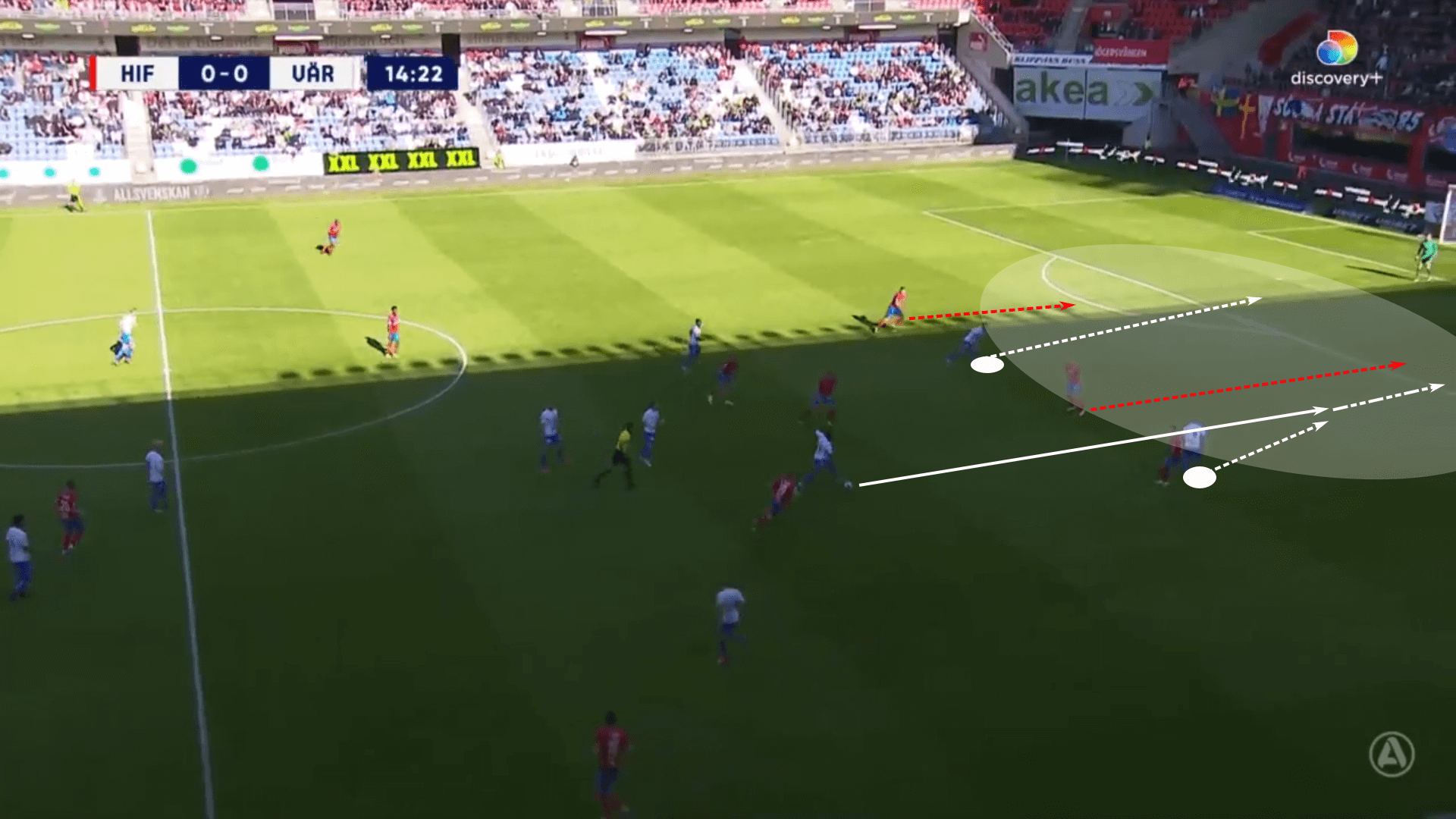
Oftentimes, it’s two out of three forwards who are making those runs behind the line. In this scenario, they enjoyed a 2v1 in the box. Unlucky for Värnamo, the central pass was blocked, taking away a golden scoring opportunity early in the match. But it’s moments like these where we see the effectiveness of the clubs attacking transition tactics and the willingness of the runners to get behind.
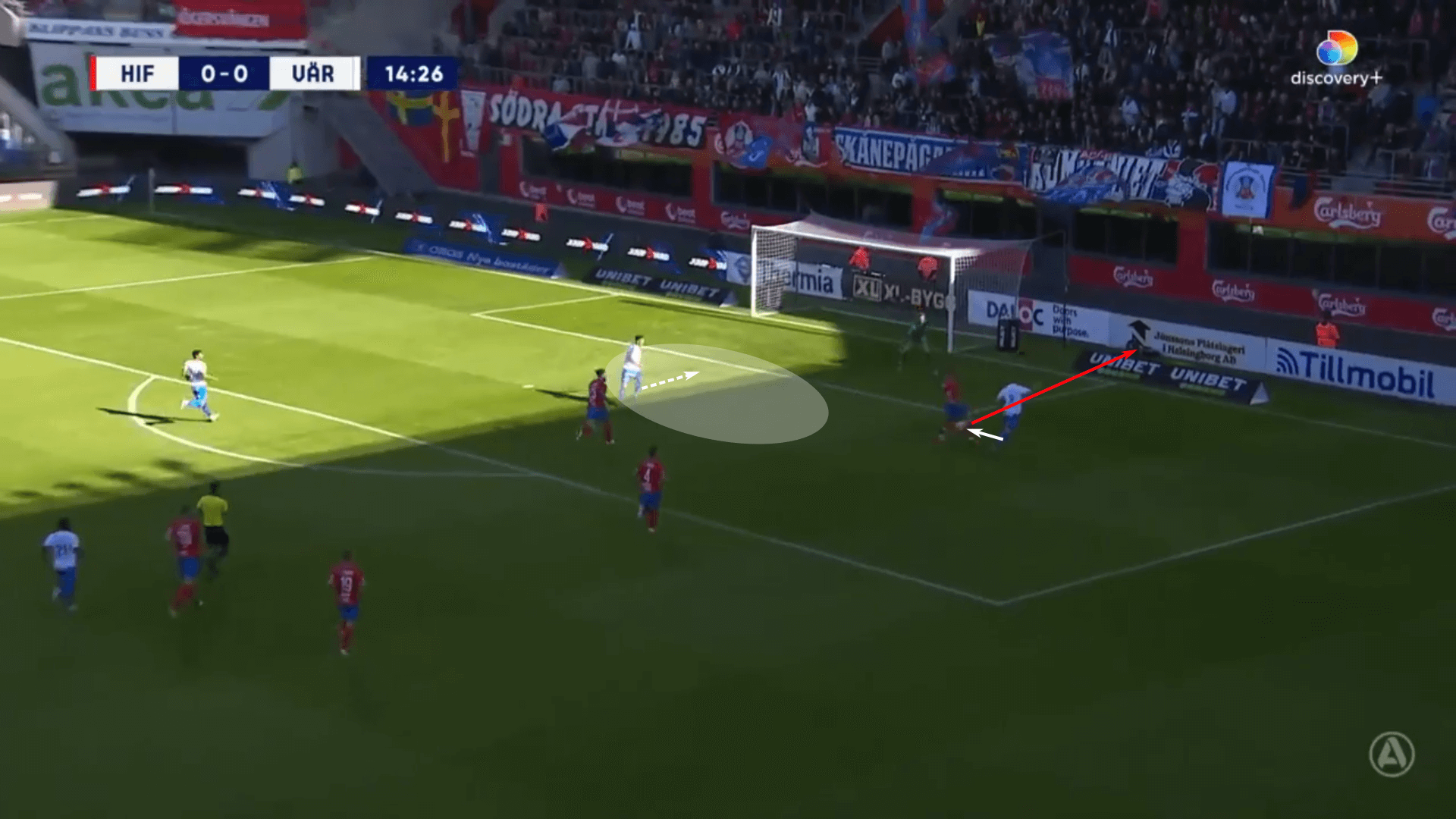
Whether in transition or open attacks, runs between and behind the lines have been a critical part of Värnamo’s recent success. They’re very active, very clever and highly coordinated, which is the defender’s nightmare.
Conclusion
Värnamo has a lot of things working against them. They’re newly promoted, one of the youngest teams in the league and they don’t have the financial resources that many other Swedish clubs enjoy. But this group…they’re clever, sophisticated and finding their rhythm. That’s a dangerous combination.
From the outside looking in, staying in the Allsvenskan is the objective. Moving past outsider expectations, Värnamo is putting in mid-table performances, which includes a 1-0 victory over then-league leaders Hammarby. With seven points in the last four games, they’ll hope to pick up where they left off before the break.
This is a side to watch, a side to study. The blend of traditional systems with contemporary concepts is an exciting blend, one that will keep the stands packed at the Finnvedsvallen Stadium.





Comments